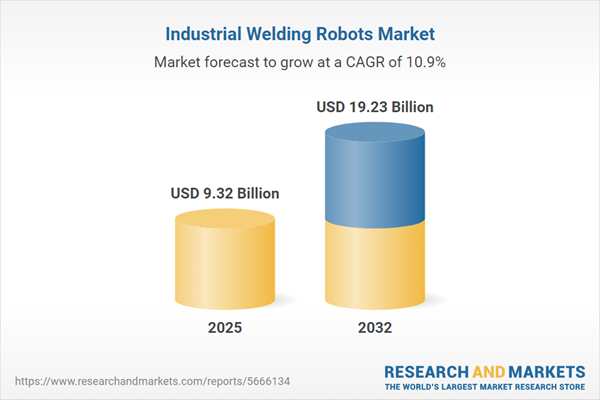Speak directly to the analyst to clarify any post sales queries you may have.
Industrial welding robots are transforming how senior leaders approach operational agility and adaptability in manufacturing. Automation technologies now offer executive teams the tools to maximize process efficiency, enhance scalability, and manage risk in an evolving competitive landscape.
Market Snapshot: Industrial Welding Robots Market Growth
The industrial welding robots market is projected to expand from USD 8.39 billion in 2024 to USD 9.32 billion in 2025, representing a compound annual growth rate (CAGR) of 10.91%. By 2032, this market could reach USD 19.23 billion. Acceleration stems from rising automation investments across key industries such as automotive, aerospace, electronics, and heavy manufacturing. Adoption of smart sensing, advanced robotics, and modern control systems is increasing production speed and improving quality control. Senior decision-makers are finding that these technologies enable their organizations to meet changing production demands—supporting shifts between small-batch, high-mix, and large-volume manufacturing with greater flexibility.
Scope & Segmentation of the Industrial Welding Robots Market
Senior leaders evaluating industrial welding robot investments should consider detailed segmentation and strategic benchmarks:
- Robot Types: Articulated, Cartesian, Collaborative, Delta, and SCARA robots support varied assembly, welding, and automation needs, letting organizations match automation options to specific production and safety requirements.
- Axis Configurations: Four, six, and seven-axis robotic options offer flexibility for both simple and complex welding processes, delivering scalability for different application demands and precision expectations.
- End-User Industries: Aerospace, automotive, electronics, general manufacturing, heavy machinery, and shipbuilding each utilize robotic welding to achieve greater throughput and minimize downtime amid rising operational demands.
- Welding Process Types: MIG, TIG, Plasma Arc, Friction Stir, Laser, Spot, and Ultrasonic welding technologies offer adaptability for varied production—supporting both standardized batch runs and specialized work.
- Payload Capacities: From lightweight to heavy-duty, robotic payload options are available to match organizational needs and enable cost-effective deployment across different material handling requirements.
- Regions Covered: Americas, Europe, Middle East, Africa, and Asia Pacific each present distinct regulatory frameworks, providing insight into compliance and investment approaches that can affect rollout strategies.
- Country Breakouts: The United States, China, Japan, India, Germany, South Korea, and Brazil are analyzed, revealing unique regional drivers and identifying areas for targeted investment and expansion.
- Leading Companies Analyzed: Assessment of FANUC Corporation, Yaskawa Electric Corporation, ABB Ltd., KUKA AG, Kawasaki Heavy Industries, Panasonic Corporation, Mitsubishi Electric Corporation, Comau S.p.A., OTC Daihen, and Nachi-Fujikoshi Corp helps benchmark industry standards and vendor selection criteria.
Key Takeaways for Senior Leaders
- Implementing industrial welding robots enhances manufacturing agility, allowing quick adaptation to changing production schedules and shifting business priorities without significant operational disruption.
- Real-time process monitoring enables transparent oversight, helping support not only compliance initiatives but also stronger, data-driven quality assurance mechanisms.
- Modular automation approaches make it possible to scale investments in robotics technology incrementally, reducing workflow interruptions and easing the adoption curve for complex process changes.
- Strategic collaboration with specialist vendors and system integrators streamlines automation alignment with operational goals, supporting targeted process improvements and smoother technology deployment.
- Prioritizing energy-efficient robotics assists companies in cost management and strengthens efforts toward sustainability and corporate governance objectives.
- Flexible robotic solutions enable swift transitions between mass production and customization, offering manufacturing organizations the versatility to respond to evolving market opportunities and demands.
Tariff Impact & Regional Dynamics
Regional regulations and shifting tariffs play a significant role in shaping procurement and investment strategies for industrial welding robots. In the United States, manufacturers increasingly consider local sourcing and robotics-as-a-service to offset market uncertainties. North American companies are prioritizing automation investments and workforce development to maintain a competitive edge. Western Europe continues to see more complex compliance requirements, driving demand for flexible automation. Asia Pacific benefits from modernization incentives that fast-track the adoption of advanced robotics. Tailoring automation approaches to local regulatory climates is essential for maximizing investment outcomes across key regions.
Methodology & Data Sources
The analysis combines data from industry associations, technical literature, corporate financials, and expert input. Findings are underpinned by proprietary shipment and trade models, providing reliable direction for market participants and decision-makers.
The Industrial Welding Robots Market: Why This Report Matters
- Provides executive teams with a reference for planning, positioning automation investments within operational models, and responding to changing market and technology trends.
- Delivers actionable intelligence for proactive risk management, compliance, and maintaining business agility during regulatory or technological transitions.
- Enables leadership to align automation strategy with long-term sustainability goals and evolving compliance expectations for greater organizational resilience.
Conclusion
Adopting insights from this report helps senior leaders advance modernization initiatives and support organizational readiness for continued success in a rapidly evolving industrial environment.
Additional Product Information:
- Purchase of this report includes 1 year online access with quarterly updates.
- This report can be updated on request. Please contact our Customer Experience team using the Ask a Question widget on our website.
Table of Contents
3. Executive Summary
4. Market Overview
7. Cumulative Impact of Artificial Intelligence 2025
Companies Mentioned
The companies profiled in this Industrial Welding Robots market report include:- FANUC Corporation
- Yaskawa Electric Corporation
- ABB Ltd.
- KUKA AG
- Kawasaki Heavy Industries, Ltd.
- Panasonic Corporation
- Mitsubishi Electric Corporation
- Comau S.p.A.
- OTC Daihen, Inc.
- Nachi-Fujikoshi Corp.
Table Information
| Report Attribute | Details |
|---|---|
| No. of Pages | 192 |
| Published | November 2025 |
| Forecast Period | 2025 - 2032 |
| Estimated Market Value ( USD | $ 9.32 Billion |
| Forecasted Market Value ( USD | $ 19.23 Billion |
| Compound Annual Growth Rate | 10.9% |
| Regions Covered | Global |
| No. of Companies Mentioned | 11 |









